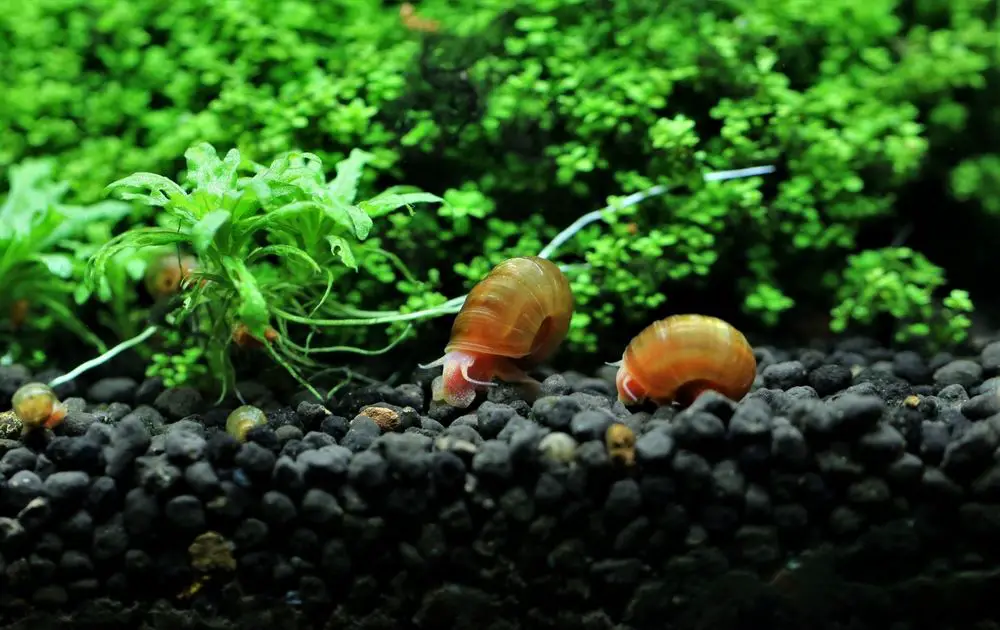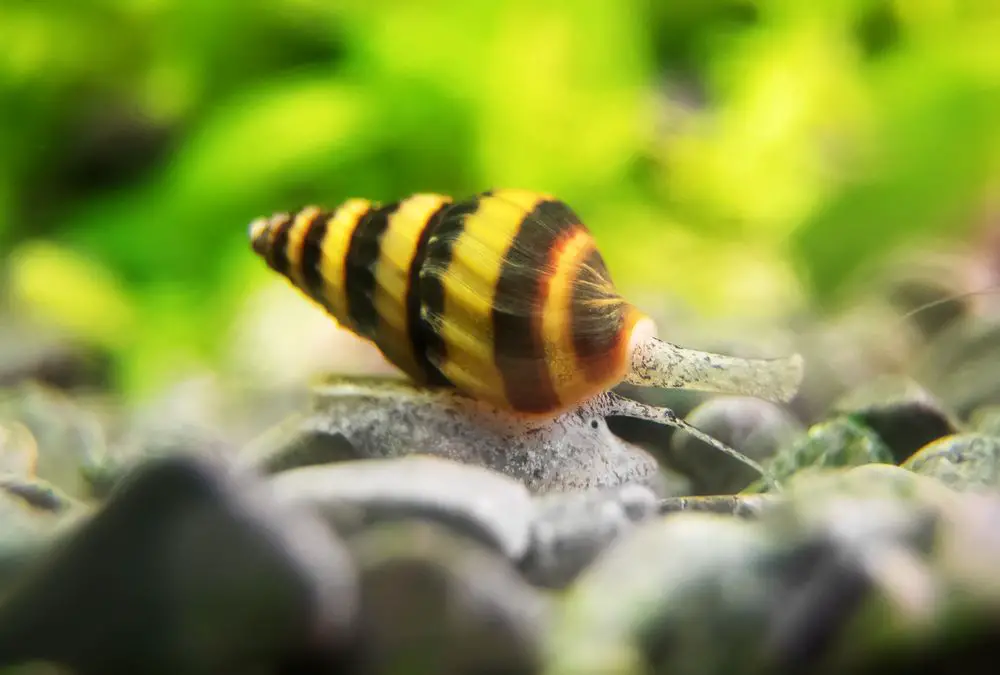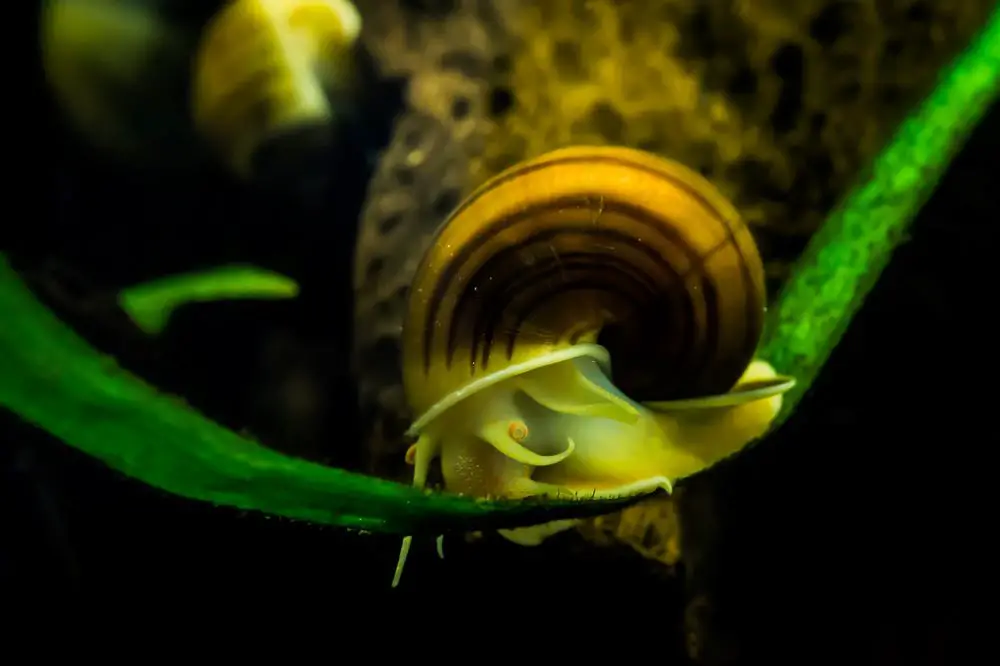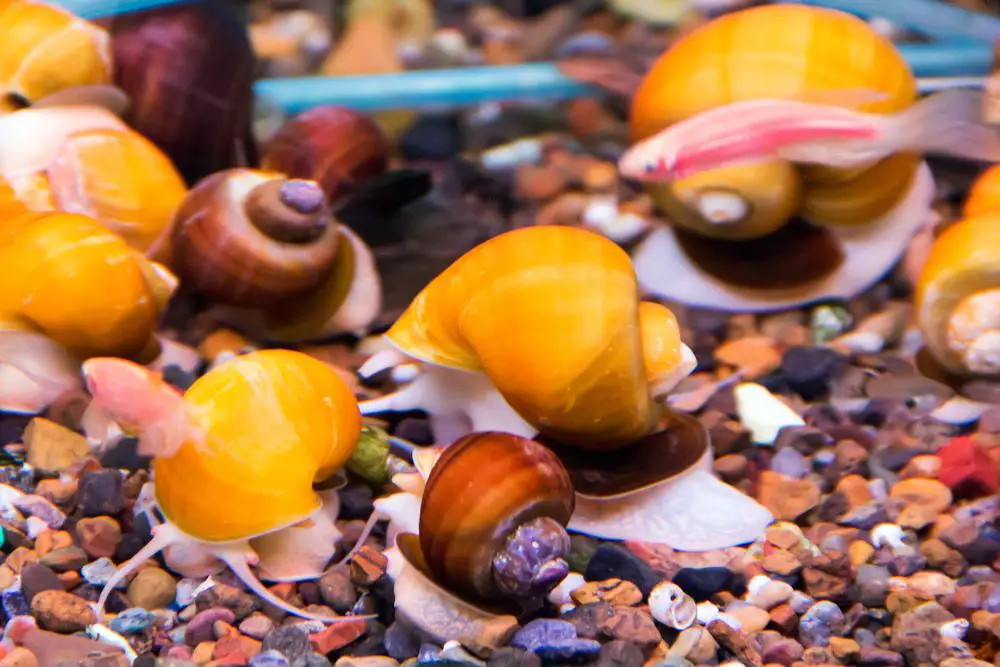Yes, snails can indeed climb out of an aquarium, especially if it’s rimless. The type of snail plays a role, with some like Nerite snails being known for their adventurous climbing. However, lowering the water level can help prevent these unexpected escapes.
As an aquarist with a soft spot for shrimp and a newfound respect for snails, I’ve had my fair share of surprises. I’ve seen snails perform feats of acrobatics that would make a circus performer blush. But can they climb out of an aquarium? Well, let’s dive into this slippery question.
Snail Behavior
Snails, like any other living creature, have their unique behaviors and quirks. As an aquarist, understanding these behaviors can help you create a more comfortable and safe environment for your slimy friends.
Snails are primarily bottom dwellers, spending most of their time exploring the substrate of your aquarium, munching on algae, and cleaning up detritus. They are excellent scavengers, making them a valuable addition to any tank’s clean-up crew.
However, snails are also known for their adventurous spirit. They love to explore their surroundings, and this includes the vertical walls of your aquarium. They can easily scale these walls, moving along the waterline and even venturing above it. This behavior is particularly common in certain species, such as Nerite snails, which are known for their climbing prowess.
Snails climb for various reasons. Some are in search of food, grazing on the algae and biofilm that accumulate on the sides of the tank. Others may be responding to changes in water conditions. If the water quality deteriorates, snails may climb to the water’s surface, where oxygen levels are typically higher.
It’s also worth noting that snails are nocturnal creatures. They are most active during the night, so don’t be surprised if you wake up to find your snails in completely different locations from where they were the previous evening.
Understanding these behaviors is crucial in preventing snails from escaping your tank and ensuring they live a happy and healthy life in your care.

Types of Snails and Their Climbing Tendencies
There are numerous types of snails that aquarists may choose to keep in their tanks, and each of these species has its unique behaviors, including climbing tendencies.
1. Nerite Snails: These are some of the most notorious climbers in the snail world. They are known to scale the walls of the tank and can often be found at the waterline or even above it. In their natural habitat, Nerite snails are known to venture out of the water, so this behavior is quite normal for them.
2. Mystery Snails: Also known as Apple snails, these creatures climb out of the tank and will often explore above the waterline to lay eggs, so don’t be surprised if you see them venturing upwards.
3. Malaysian Trumpet Snails (MTS): These snails are burrowers and spend most of their time in the substrate of the tank. They are less likely to climb the tank walls, but they can still do so, especially if the water conditions are not ideal.
4. Assassin Snails: These snails are carnivorous and are often kept in tanks to control populations of other snail species. They are not known for their climbing abilities and are more likely to be found hunting on the substrate.
5. Pond Snails: These snails are often considered pests, but they can also be beneficial for controlling algae. They are known to climb and can often be found at the waterline.
6. Ramshorn Snails: These snails are named for their unique shell shape. They are avid climbers and will often be found on the tank walls, decorations, and plant leaves.
Remember, while some snails are more prone to climbing than others, any snail can potentially climb out of a tank, especially if the conditions within the tank are not ideal. Regular monitoring and maintenance of water conditions are crucial to keep your snails happy and prevent them from making a daring escape.
Preventing Snail Escapes: Practical Tips
While seeing a snail making a daring escape can be amusing, it’s not ideal for the snail or the aquarist. Here are some practical tips to prevent your snails from climbing out of your aquarium:
1. Maintain Optimal Water Conditions: Snails often climb out of the water when the conditions are not ideal. This could be due to poor water quality, incorrect temperature, or lack of food. Regularly testing your water parameters and making necessary adjustments can help keep your snails content and less likely to attempt an escape.
2. Lower the Water Level: If you have a rimless tank, consider lowering the water level a few inches below the top. This creates a barrier that can deter most snails from climbing out.
3. Use a Tank Lid: A lid can be a simple and effective solution to prevent snails from escaping. Just ensure that there’s still adequate ventilation for gas exchange.
4. Provide Plenty of Food: Snails often climb in search of food. By ensuring that there’s enough food at the bottom of the tank, you can discourage them from venturing too far.
5. Regularly Check for Escaped Snails: Despite your best efforts, some snails might still manage to escape. Regularly check around your tank for any adventurous mollusks and gently place them back into the water if you find any.
6. Choose Less Adventurous Species: If you’re particularly concerned about snails escaping, consider choosing species that are less prone to climbing, such as Malaysian Trumpet Snails.
Remember, a happy snail is less likely to try to escape. By understanding their needs and behaviors, you can create an environment where your snails feel safe, satisfied, and less inclined to go on an adventurous climb.

The Role of Aquarium Design in Snail Escapes
The design of your aquarium plays a significant role in whether your snails are likely to attempt an escape. Here are some factors to consider:
1. Rimless Tanks: Rimless tanks are popular for their sleek, modern look. However, they also make it easier for snails to climb out. If you have a rimless tank, consider lowering the water level to create a barrier that snails will find difficult to cross.
2. Tank Lid: A lid can be a simple and effective way to prevent snails from escaping. However, it’s important to ensure that the lid allows for adequate ventilation and light penetration. Some lids also have small gaps or openings for equipment wires, which can provide an escape route for small or determined snails.
3. Substrate and Decorations: The type and arrangement of substrate and decorations can influence snail behavior. Snails may be more likely to climb if they can easily reach the top of the tank by climbing on tall plants or decorations. On the other hand, a tank with plenty of hiding spots and food sources at the bottom may encourage snails to stay low.
4. Water Level: As mentioned earlier, the water level can influence snail behavior. A high water level that reaches the top of the tank can make it easier for snails to climb out. Lowering the water level can help deter snails from escaping.
5. Tank Size: The size of the tank can also play a role. In a small, crowded tank, snails may be more likely to climb out in search of more space or better conditions. Providing ample space for all your tank inhabitants can help keep everyone happy and reduce the likelihood of escapes.
While you can’t completely eliminate the possibility of snails escaping, thoughtful aquarium design can significantly reduce the risk. By considering the needs and behaviors of your snails when setting up your tank, you can create an environment that keeps your snails safe, happy, and less likely to attempt a daring escape.

Snails and Algae: A Love Story
In the world of aquariums, snails and algae share a relationship that can only be described as a love story. As diligent cleaners, Snails have a particular fondness for algae, which often forms a significant part of their diet.
Snails will often leave the water to eat algae that’s growing above the water line.
1. Algae as a Food Source: Algae, whether it’s green, brown, or any other color, is a favorite snack for many snail species. They graze on the algae that naturally grows on the tank walls, substrate, and decorations, helping to keep your aquarium clean and algae-free.
This is one of the reasons why snails are often introduced into aquariums – to control algae growth.
Snails will often leave the water to eat algae that’s growing above the water line.
2. Algae and Snail Health: Algae is not just a food source for snails; it’s also crucial for their health. It provides them with necessary nutrients, including carbohydrates and proteins. Some types of algae can also be a source of calcium, which snails need for shell development and growth.
3. Algae and Snail Behavior: The presence of algae can influence snail behavior. Snails are more likely to be active and explore their tank when there’s plenty of algae to eat. This includes climbing the tank walls, where they can often be seen scraping off and consuming the thin layer of algae that forms there.
4. Algae Blooms and Snail Population: In some cases, an abundance of algae can lead to a population boom in snails, especially if there are no natural predators in the tank. This is often the case with pest snails like bladder snails or ramshorn snails, which can quickly overrun a tank if there’s plenty of food.
5. The Role of Snails in Algae Control: While snails can help control algae, they’re not a complete solution. They can’t eat all types of algae, and they can’t keep up if the algae growth is too rapid. Other methods, such as adjusting lighting and nutrient levels, are often needed for effective algae control.

Conclusion
In the vast and diverse world of aquarium keeping, snails play a crucial role. They are the unsung heroes, diligently cleaning our tanks, controlling algae, and contributing to the ecosystem’s overall health. However, their adventurous nature can sometimes lead them to climb out of the tank, a behavior that can be managed with the right knowledge and strategies.
Remember, maintaining optimal water conditions, understanding the behavior of different snail species, and designing your aquarium thoughtfully can significantly reduce the risk of snail escapes. And while snails and algae share a love story, remember that snails alone can’t solve an algae problem.
In the end, it’s all about balance and understanding the unique needs and behaviors of your tank’s inhabitants. Don’t hesitate to reach out if you ever need help navigating the fascinating world of snails and shrimp keeping.
Happy Snail Keeping!
Frequently Asked Questions
Q. Can snails survive outside the aquarium? A. Yes, some snails can survive outside the aquarium for a period of time, especially if the environment is humid. However, they can’t survive indefinitely and should be returned to the water as soon as possible to prevent dehydration.
Q. How can I tell if my snail is trying to escape due to poor water conditions? A. If you notice your snails are frequently climbing the walls of the tank and gathering near the water surface, this could be a sign of poor water conditions. Regularly test your water parameters to ensure they are within the appropriate range for your snail species.
Q. What should I do if I find a snail outside the tank? A. If you find a snail outside the tank, gently pick it up and place it back in the water. Check the conditions in your tank to see if there might be a reason why the snail tried to escape.
Q. Can snails harm my aquarium plants? A. Most aquarium snails are harmless to plants and can actually benefit them by cleaning off algae. However, some species, like the Apple Snail, can eat plants and may not be suitable for a planted tank.
Q. How many snails should I have in my aquarium? A. The number of snails you should have depends on the size of your tank and the species of snail. As a general rule, you should consider the bioload of the snails and ensure your tank has enough space and resources to support them.
Q. Do snails reproduce quickly in the aquarium? A. Some snails, like the Ramshorn and Pond snails, can reproduce quickly and overrun a tank if conditions are favorable. Others, like Nerite snails, only breed in brackish water and are unlikely to reproduce in a freshwater aquarium.
